Reminiscences of a Raleigh Boy: Part 6
From Treasure to Trash: The Demolition of the Wake County Courthouse
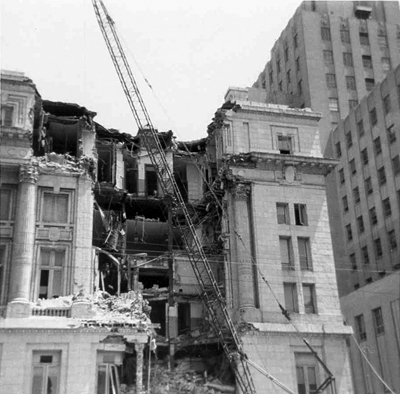
When I was a teenager back in the mid-1960s, Raleigh was fast losing all too many of its architecturally significant buildings to the wrecker’s ball. These included most of the grand Victorian homes on Blount Street, the magnificently turreted Chateauesque style Mansion Park Hotel, (which I referred to then as The Castle), the Jacobethan style Hugh Morson High School, Sullivanesque Wachovia Bank building, Italian Renaissance Olivia Raney Library and Wake County’s Beaux Arts courthouse. Downtown Raleigh back then was a veritable treasure trove of late 19th and early 20th century American architecture.
Luckily, I was able to capture these remarkable structures in black and white snapshots taken with my trusty Kodak Instamatic Camera. Although I didn’t realize it at the time, I had inadvertently documented these now long-gone buildings, which are today but a faded memory.
Raleigh’s Wake County Courthouse was an imposing structure. Sheathed in decorative cast white terra cotta, the massive building evoked an image of a giant wedding cake. Its design, by the renowned Atlanta architect, Philip Thornton Marye, was a restrained take on the Beaux Arts Classicist style, popular for government and public buildings at the time.
Marye had already completed Raleigh’s City Hall and Auditorium (1911), which stood on the site of the present-day “Little Seagram Building†on Fayetteville Street, and Raleigh’s first “real†skyscraper, the Commercial National Bank (1912), a masterpiece in the Gothic Revival style. (That ten-story building proudly stood at the corner of Martin and Wilmington Streets, until First Citizens Bank, in an unfortunate fit of myopia, imploded this irreplaceable treasure in 1991.)
In 1913 the state of North Carolina commissioned Marye to design its Administration Building (now the Ruffin Building) on Capitol Square. And Wake County followed suit with its stylish new county courthouse in 1915.
By the mid-1960s, the county had decided to replace its classic “temple of justice†courthouse with a non-descript cast aggregate-stone office tower. Demolition of the doomed structure began in the spring of 1966. As with all the demolition projects going on in Raleigh back then, I was wildly fascinated! On my weekend forays downtown I studiously photographed the grand building’s demise over the course of the next several months. By midsummer 1967 it was gone.
Situated on the courthouse lawn, along with a couple of shade trees, were a modest granite monument to WWI nurses and a ten-foot bronze replica of the Statue of Liberty, which was elevated upon a stone pedestal. I remember reading the plaque on the statue’s base, but for the life of me, I can’t remember one word now. I don’t know what became of these two downtown landmarks, but I imagine they probably were unceremoniously scooped up by the bulldozers, dumped in with the rest of the courthouse rubble, and carted off to the county landfill. What a lamentable loss it all was — from treasure to trash.

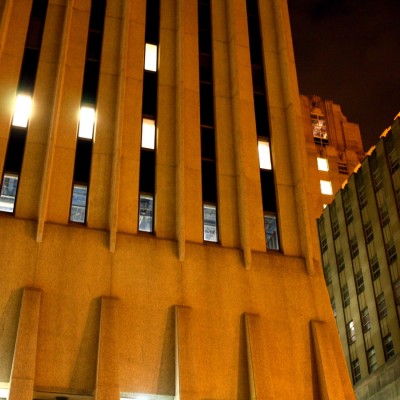
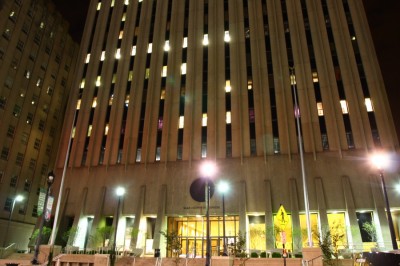
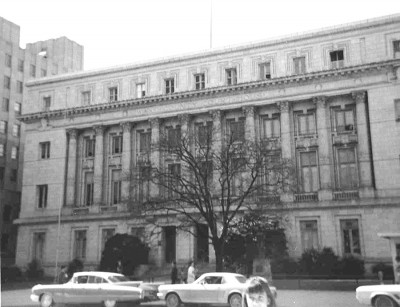
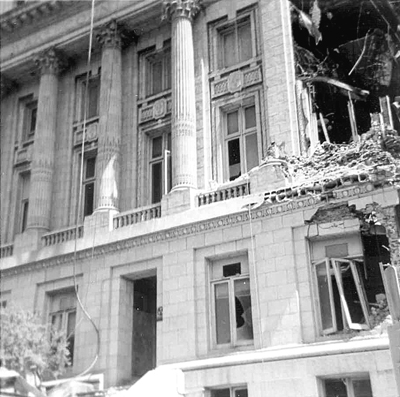

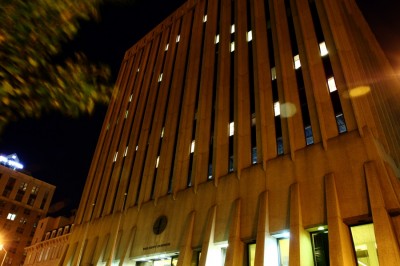

 Sign up for the Newsletter
Sign up for the Newsletter
09/28/2008
That makes me ill just thinking about that beautiful torn down building.
Do you happen to have (or can point me toward) a photo of that gothic revival Commercial National Bank of 1912?
Carol
09/29/2008
Sure Carol. Here’s a couple internet sites for you. This one shows a couple different views and gives an outline of its history: http://www.emporis.com/en/wm/bu?id=commercialnationalbankbuilding-raleigh-nc-usa
Here is a rare view of the interior from 1918:
http://flickr.com/photos/37655252@N00/446009416/
There’s also a new book out, Historic Photos of Raleigh-Durham, that shows it and lots of other rare photos of downtown Raleigh, too!
http://www.amazon.com/Historic-Photos-Raleigh-Durham-Photos/dp/1596523387/ref=sr_1_1?ie=UTF8&s=books&qid=1222691331&sr=1-1
10/12/2009
Unfortunately, as sad as it is to say, but this building probably HAD to be razed. There is no way it would be big enough to keep up with all the people that come there on a daily basis in this day and time. Great information as usual!
07/06/2010
What I remember most about the old courthouse was that during Christmas Santa Claus was stationed in front in a small open structure. That was back in the early 50’s.
07/08/2010
Hmm, I remember visiting Santa inside Hudson Belk across the street, sorta. I was pretty young then. But I do, however, vividly remember Jack Deal. He was a devoted member of the Salvation Army, and every Christmas, proudly wearing his full SA uniform — dark blue, regulation cap, brass buttons and all — he would station himself with his red kettle in front of Hudson Belk and play Christmas carols on his accordian. Even at my young age his devotion to his mission touched me. I don’t think casual passersby even knew that Jack was blind. When he passed away in the 1970s, I remember an SA official commenting to the N&O that ‘Jack died yesterday, and woke up today and saw Jesus.’
11/16/2010
Thanks for reminding me about Jack. I too remember him playing; he also visited our church on several occasions.
11/23/2012
I might be going to hell for saying this, but I actually kinda like the courthouse. What’s bizarre is I remember hating it tremendously back in the day, but it’s grown on me.
12/09/2012
Does anyone know of any of the more historic cases or other historic events/people that took place in the Wake Court House from 1915 to 1966?
12/11/2012
As Christmas approaches, I think back to the times of going down to the old courthouse where a wooden structure was erected to house Santa Claus in front of the courthouse. This was back in the early 50’s.
12/20/2012
Are there any pictures of the inside of the 1915 – 1966 Wake County Court House building? Especially the judge & jury box & cases in action in the courtrooms. Of course buildings have their architectural history but a significant architectural structure also defines itself in the cases and people of the times that brought the court house to life.
Surely there are stories and cases that reflect NC times & the issues during that time.
Please share.
Thanks, Bill
03/29/2014
My father worked at the post office during the 1960’s and watched the demolition. He did purchase some of the old timbers and windows for use on the farm. Some womderful wood was saved.
03/30/2014
It is truly a significant architectural building.
Does anyone know of a sensational trial or famous lawyer that might have given the building a special place in history?
And are there any pictures of the inside of the building of an important trial, etc.?
Thanks, Bill
05/04/2014
Does anyone know where I can find a picture of the small Statue of Liberty that stood of Fayetteville St near the old courthouse and post office. Other readers have written that it was placed there by the Boy Scouts in 1950. It is a special part of my childhood memories. apparently it has never been located. than you.
05/05/2014
Someone mentioned Jack (whose last name I do not recall . . . don’t know if I ever knew it). I helped him across the street many times. What you might not know is that Jack, Paul Montgomery (Uncle Paul from WRAL-TV), and Arthel “Doc” Watson were all at the school for the blind together, I would guess some time in the 1940s but maybe earlier.
I remember going to concerts to hear Doc Watson and his son sing and play. When he came on stage, Paul M. would call out to welcome him. Doc’s face would light up.
Ronnie Milsap also attended the school for the blind.
12/09/2015
What happened to the statue/fountain?
After the Spanish flu epidemic of 1917/18, a memorial fountain to nursing was erected on the front lawn of the 1915 Wake County Court House. The court house building was demolished in 1966. The plaque from the memorial/fountain enumerating the nurses the NC State students who died from the flu is likely housed in the archives of the University.
Anyone know:
Was the statue/memorial on the north or south lawn of the Court House?
Was it made of stone or metal?
MOST IMPORTANTLY….does anyone know of its fate?
01/07/2024
I think I know where that 10-foot replica of the Statue of Liberty is. It was moved to “temporary” storage during construction of the ill-fated Fayetteville Street pedestrian mall. Hudson Belk department store had buildings on both sides of the street, connected by a tunnel. The Belk buildings are gone, but I suspect the tunnel still exists and that statue is in it.